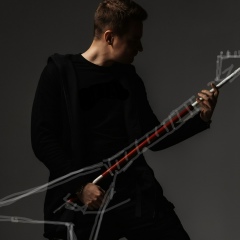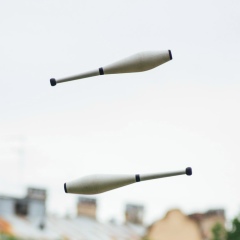Это, пожалуй, самый большой data share в нейронауке, который я когда-либо видел.
Начну издалека, зачем все это нужно. Для того, чтобы понять как именно мозг работает, нужно уметь записывать активность отдельных нейронов, а также популяций клеток и отдельных структур во время выполнения какой-либо задачи. Понятно, что делать такие записи крайне трудно, поскольку во время эксперимента мозг должен оставаться живым и более того быть способным решать задачу.
О визуализации активности на уровне отдельных нейронов мозга давно мечтал еще Чарльз Шеррингтон (https://ru.wikipedia.org/wiki/Шеррингтон,_Чарльз_Скотт), который представлял разряды отдельных нейронов в виде загорающихся лампочек. Сейчас ученые далеко продвинулись на пути к этой цели с помощью кальциевого имаджинга. Дело в том, что каждый раз, когда нейрон разряжается, изменяется концентрация кальция внутри клетки. Это изменение можно измерить с помощью красителя, который можно добавить в клетки генетически. Довольно давно ученые научились выводить трансгенных животных вроде мышей, у которых все нейроны имеют такой индикатор, GCamp (https://en.wikipedia.org/wiki/GCaMP). Таким образом за активностью отдельных клеток можно следить, просто сделав небольшое отверстие в черепе, наблюдая за происходящим в мозге через флуоресцентный микроскоп.
Следующий вопрос, в том, как интерпретировать такую активность. Поскольку все нейроны генерируют спайки вне зависимости от того, есть стимул или нет, в интерпретации такого сигнала можно легко потонуть. Иными словами разделить активность мозга на ту, которая есть сама по себе и ту, которая вызвана стимулом крайне непросто. Чтобы понять что к чему, ученые изучают сенсорные области коры, в частности зрительную кору, которая изучена лучше остальных. Именно эта кора, а именно первичная зрительная ее часть V1 (https://ru.wikipedia.org/wiki/Зрительная_кора) первой получает информацию от глаз (сетчатка -> таламус -> V1).
Так вот, возвращаясь к данным. Исследователи института Аллана (https://en.wikipedia.org/wiki/Allen_Institute_for_Brain_Science) записали такую активность у множества мышей, которые не только смотрели на скучные стимулы вроде полосок, шума и градиентов, а также на фотки природы и даже фильм Печать зла Уэллса (https://en.wikipedia.org/wiki/Touch_of_Evil)! Помимо того, что фильм смотреть мышам было интереснее, чем наблюдать за полосками на экране (привет, антропоцентризм), фильм или непрерывный поток зрительной информации гораздо лучше описывает то, что действительно попадает на сетчатку во время зрения. В то время как полоски и градиенты - просто тестовые стимулы.
Но одной записью дело не ограничилось, несколько дней назад они опубликовали эти данные в открытом доступе! Теперь любой желающий может зайти на сайт (http://observatory.brain-map.org/visualcoding), скачать Jupiter Notebook и пару модулей, а также собственно данные. По мнению авторов это должно стимулировать нейроученых по всему миру лучше понять как происходит обработка информации в мозге на примере зрения, как наиболее изученной области.
По-моему, это безумно круто! Стоит отметить, что биоинформатики уже давно делятся данными между собой, в то время, как в нейробиологии этот момент пока не наступил. Полагаю, что это связано с типами данных. К примеру, какой-нибудь последовательностью вроде ATTG... гораздо проще поделиться и сложнее неверно интерпретировать по сравнению с кальциевым сигналом от нейрона, интерпретация которого зависит от алгоритма обработки, а также типа кальциевого индикатора. Помимо этого есть нерешенный вопрос первого авторства в публикации, но об этом в другой раз. По этой причине пока никто данными особо не делится в среде нейробиологов даже после публикации работ, что сильно замедляет общий прогресс. Так вот институт Аллана сделал большой шаг вперед в этом направлении. Будем надеяться, что многие последуют этому примеру и данные, как и совместные работы экспериментаторов и теоретиков станут более частым явлением.
#нейротоля
https://www.youtube.com/watch?v=056x1RTyB_M
Начну издалека, зачем все это нужно. Для того, чтобы понять как именно мозг работает, нужно уметь записывать активность отдельных нейронов, а также популяций клеток и отдельных структур во время выполнения какой-либо задачи. Понятно, что делать такие записи крайне трудно, поскольку во время эксперимента мозг должен оставаться живым и более того быть способным решать задачу.
О визуализации активности на уровне отдельных нейронов мозга давно мечтал еще Чарльз Шеррингтон (https://ru.wikipedia.org/wiki/Шеррингтон,_Чарльз_Скотт), который представлял разряды отдельных нейронов в виде загорающихся лампочек. Сейчас ученые далеко продвинулись на пути к этой цели с помощью кальциевого имаджинга. Дело в том, что каждый раз, когда нейрон разряжается, изменяется концентрация кальция внутри клетки. Это изменение можно измерить с помощью красителя, который можно добавить в клетки генетически. Довольно давно ученые научились выводить трансгенных животных вроде мышей, у которых все нейроны имеют такой индикатор, GCamp (https://en.wikipedia.org/wiki/GCaMP). Таким образом за активностью отдельных клеток можно следить, просто сделав небольшое отверстие в черепе, наблюдая за происходящим в мозге через флуоресцентный микроскоп.
Следующий вопрос, в том, как интерпретировать такую активность. Поскольку все нейроны генерируют спайки вне зависимости от того, есть стимул или нет, в интерпретации такого сигнала можно легко потонуть. Иными словами разделить активность мозга на ту, которая есть сама по себе и ту, которая вызвана стимулом крайне непросто. Чтобы понять что к чему, ученые изучают сенсорные области коры, в частности зрительную кору, которая изучена лучше остальных. Именно эта кора, а именно первичная зрительная ее часть V1 (https://ru.wikipedia.org/wiki/Зрительная_кора) первой получает информацию от глаз (сетчатка -> таламус -> V1).
Так вот, возвращаясь к данным. Исследователи института Аллана (https://en.wikipedia.org/wiki/Allen_Institute_for_Brain_Science) записали такую активность у множества мышей, которые не только смотрели на скучные стимулы вроде полосок, шума и градиентов, а также на фотки природы и даже фильм Печать зла Уэллса (https://en.wikipedia.org/wiki/Touch_of_Evil)! Помимо того, что фильм смотреть мышам было интереснее, чем наблюдать за полосками на экране (привет, антропоцентризм), фильм или непрерывный поток зрительной информации гораздо лучше описывает то, что действительно попадает на сетчатку во время зрения. В то время как полоски и градиенты - просто тестовые стимулы.
Но одной записью дело не ограничилось, несколько дней назад они опубликовали эти данные в открытом доступе! Теперь любой желающий может зайти на сайт (http://observatory.brain-map.org/visualcoding), скачать Jupiter Notebook и пару модулей, а также собственно данные. По мнению авторов это должно стимулировать нейроученых по всему миру лучше понять как происходит обработка информации в мозге на примере зрения, как наиболее изученной области.
По-моему, это безумно круто! Стоит отметить, что биоинформатики уже давно делятся данными между собой, в то время, как в нейробиологии этот момент пока не наступил. Полагаю, что это связано с типами данных. К примеру, какой-нибудь последовательностью вроде ATTG... гораздо проще поделиться и сложнее неверно интерпретировать по сравнению с кальциевым сигналом от нейрона, интерпретация которого зависит от алгоритма обработки, а также типа кальциевого индикатора. Помимо этого есть нерешенный вопрос первого авторства в публикации, но об этом в другой раз. По этой причине пока никто данными особо не делится в среде нейробиологов даже после публикации работ, что сильно замедляет общий прогресс. Так вот институт Аллана сделал большой шаг вперед в этом направлении. Будем надеяться, что многие последуют этому примеру и данные, как и совместные работы экспериментаторов и теоретиков станут более частым явлением.
#нейротоля
https://www.youtube.com/watch?v=056x1RTyB_M
This is perhaps the largest data share in neuroscience I have ever seen.
I'll start from afar, why all this is needed. In order to understand exactly how the brain works, you need to be able to record the activity of individual neurons, as well as populations of cells and individual structures during the performance of a task. It is clear that making such records is extremely difficult, since during the experiment the brain must remain alive and, moreover, be able to solve the problem.
Charles Sherrington (https://ru.wikipedia.org/wiki/Sherrington,_Charles_Scott), who represented the discharges of individual neurons in the form of illuminating bulbs, had long dreamed of visualizing activity at the level of individual neurons of the brain. Now, scientists have made great strides towards this goal with calcium imaging. The fact is that every time a neuron is discharged, the concentration of calcium inside the cell changes. This change can be measured using a dye that can be added genetically to cells. Quite a long time ago, scientists learned to display transgenic animals like mice in which all neurons have such an indicator, GCamp (https://en.wikipedia.org/wiki/GCaMP). Thus, the activity of individual cells can be monitored simply by making a small hole in the skull, observing what is happening in the brain through a fluorescence microscope.
The next question is how to interpret such activity. Since all neurons generate spikes regardless of whether there is a stimulus or not, the interpretation of such a signal can easily sink. In other words, to divide the activity of the brain into that which is in itself and that which is caused by the stimulus is extremely difficult. To understand what’s what, scientists study the sensory areas of the cortex, in particular the visual cortex, which has been studied better than others. It is this cortex, namely its primary visual part V1 (https://ru.wikipedia.org/wiki/ Visual_Cort) that first receives information from the eyes (retina -> thalamus -> V1).
So, back to the data. Researchers at the Allan Institute (https://en.wikipedia.org/wiki/Allen_Institute_for_Brain_Science) recorded such activity in a lot of mice that not only looked at boring stimuli like stripes, noise and gradients, but also at nature pictures and even the print of Wells Evil (https://en.wikipedia.org/wiki/Touch_of_Evil)! Besides the fact that it was more interesting for mice to watch a film than to watch the stripes on the screen (hello, anthropocentrism), a film or a continuous stream of visual information much better describes what really hits the retina during vision. While stripes and gradients are just test incentives.
But the matter was not limited to one record, a few days ago they published this data in the public domain! Now anyone can go to the site (http://observatory.brain-map.org/visualcoding), download the Jupiter Notebook and a couple of modules, as well as the data itself. According to the authors, this should encourage neuroscientists around the world to better understand how information is processed in the brain using the example of vision as the most studied area.
In my opinion, this is insanely cool! It is worth noting that bioinformatics have long been sharing data with each other, while in neuroscience this moment has not yet arrived. I believe this is related to data types. For example, a sequence like ATTG ... is much easier to share and more difficult to interpret incorrectly compared to a calcium signal from a neuron, the interpretation of which depends on the processing algorithm, as well as the type of calcium indicator. In addition, there is an unresolved issue of the first authorship in the publication, but more on that another time. For this reason, so far no one particularly shares data among neurobiologists even after the publication of works, which greatly slows down the overall progress. So the Allan Institute took a big step forward in this direction. Let us hope that many will follow this example and the data, as well as the joint work of experimenters and theorists, will become more frequent.
# neurotol
https://www.youtube.com/watch?v=056x1RTyB_M
I'll start from afar, why all this is needed. In order to understand exactly how the brain works, you need to be able to record the activity of individual neurons, as well as populations of cells and individual structures during the performance of a task. It is clear that making such records is extremely difficult, since during the experiment the brain must remain alive and, moreover, be able to solve the problem.
Charles Sherrington (https://ru.wikipedia.org/wiki/Sherrington,_Charles_Scott), who represented the discharges of individual neurons in the form of illuminating bulbs, had long dreamed of visualizing activity at the level of individual neurons of the brain. Now, scientists have made great strides towards this goal with calcium imaging. The fact is that every time a neuron is discharged, the concentration of calcium inside the cell changes. This change can be measured using a dye that can be added genetically to cells. Quite a long time ago, scientists learned to display transgenic animals like mice in which all neurons have such an indicator, GCamp (https://en.wikipedia.org/wiki/GCaMP). Thus, the activity of individual cells can be monitored simply by making a small hole in the skull, observing what is happening in the brain through a fluorescence microscope.
The next question is how to interpret such activity. Since all neurons generate spikes regardless of whether there is a stimulus or not, the interpretation of such a signal can easily sink. In other words, to divide the activity of the brain into that which is in itself and that which is caused by the stimulus is extremely difficult. To understand what’s what, scientists study the sensory areas of the cortex, in particular the visual cortex, which has been studied better than others. It is this cortex, namely its primary visual part V1 (https://ru.wikipedia.org/wiki/ Visual_Cort) that first receives information from the eyes (retina -> thalamus -> V1).
So, back to the data. Researchers at the Allan Institute (https://en.wikipedia.org/wiki/Allen_Institute_for_Brain_Science) recorded such activity in a lot of mice that not only looked at boring stimuli like stripes, noise and gradients, but also at nature pictures and even the print of Wells Evil (https://en.wikipedia.org/wiki/Touch_of_Evil)! Besides the fact that it was more interesting for mice to watch a film than to watch the stripes on the screen (hello, anthropocentrism), a film or a continuous stream of visual information much better describes what really hits the retina during vision. While stripes and gradients are just test incentives.
But the matter was not limited to one record, a few days ago they published this data in the public domain! Now anyone can go to the site (http://observatory.brain-map.org/visualcoding), download the Jupiter Notebook and a couple of modules, as well as the data itself. According to the authors, this should encourage neuroscientists around the world to better understand how information is processed in the brain using the example of vision as the most studied area.
In my opinion, this is insanely cool! It is worth noting that bioinformatics have long been sharing data with each other, while in neuroscience this moment has not yet arrived. I believe this is related to data types. For example, a sequence like ATTG ... is much easier to share and more difficult to interpret incorrectly compared to a calcium signal from a neuron, the interpretation of which depends on the processing algorithm, as well as the type of calcium indicator. In addition, there is an unresolved issue of the first authorship in the publication, but more on that another time. For this reason, so far no one particularly shares data among neurobiologists even after the publication of works, which greatly slows down the overall progress. So the Allan Institute took a big step forward in this direction. Let us hope that many will follow this example and the data, as well as the joint work of experimenters and theorists, will become more frequent.
# neurotol
https://www.youtube.com/watch?v=056x1RTyB_M
У записи 7 лайков,
2 репостов.
2 репостов.
Эту запись оставил(а) на своей стене Анатолий Бучин


























